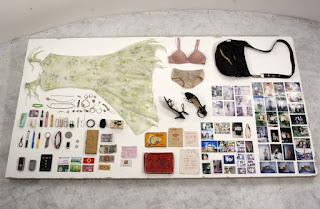Constructing a character
with objects
Using
personal objects in art means the construction of a character in its most
intimate ways. Even if the personal objects belong to the artist, there is a
construction of the character of the artist; the projection of his/her persona
in specific contexts. For example, Hale Tenger’s large scale installation Sandık Odası (1997) turns the exhibition
space into the inside of a home, partly based on a past home of hers. It
carries the context of 80s Turkey, its political and cultural environment into
a personal space. Each object points towards a certain feeling, and is powered
by the artist’s memories and curation. The personal objects and memories
suggest the collective memory of a culture.
Hale Tenger, Sandık Odası, 1997
Ilya
Kabakov’s The Man Who Never Threw
Anything Away (1996) is another example of character constructing through
objects. As the title of the work strongly suggests, Kabakov’s imaginary
character holds on to every item he owns, in the effort to hold on to every
memory. The objects connect to each other to form a meaningful whole, an
archive of a life. Each object is carefully documented with a little note next
to it; enhancing the idea that this is indeed an archive. In contrast to
Tenger’s Sandık Odası, the space is
organized almost like a museum, with displays and explanatory captions. The
title of the work suggests the act of hoarding, but the display and
organization contradicts this premise. The viewer is forced to assume that each
object, however mundane, carries a meaning.
Ilya Kabakov, The Man Who Never Threw Anything Away, 1996
In Liu
Chuang’s Buying Everything On You (2006-present),
it is the viewer that constructs, or imagines the character. Chuang offers money
to strangers on the street in exchange for everything they have on them at that
moment. The result is a display of neatly arranged items on a white surface:
wallets, clothes, underwear, phones, keys, receits, shoes, etc. Like Kabakov’s
objects, Chuang’s displays are also too
neat, like they have been recovered from a crime scene and layed out on the
table for registration and examination. The eerie display of these objects
enhances the viewer’s urge to ‘investigate’ this absent owner and imagine a
character based on the evidence.
Liu Chuang, Buying Everything On You, 2006-present






